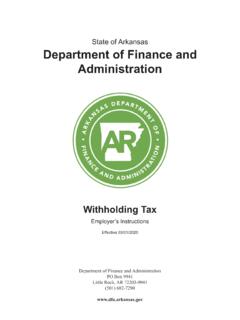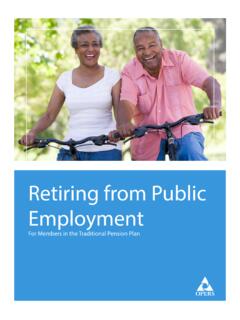Transcription of LEOFF Plan 2 Retirement Know -how
1 LEOFF Plan 2 Retirement Know-how 1 Introduction The three major elements of your Retirement portfolio include your LEOFF 2 Pension, Social Security, and Personal Savings. Many LEOFF 2 members do not have access to Social Security. If this is you, then it is very important to focus on investing in personal savings for your Retirement . This publication provides: A plan summary Retirement planning considerations Retirement ready options and considerations, including o estimating your benefit o Purchasing an annuity o Purchasing additional service credit o Deferred Compensation or other deferred savings programs o Retirement application process o Insurance coverage for medical, life and long-term care o Social Security Post- Retirement Information Retirement checklists for financial and estate planning, and Retirement Contact information Plan Summary LEOFF Plan 2 is a defined benefit plan.
2 When you meet plan requirements and retire, you are guaranteed a monthly benefit for the rest of your life. You earn this right by being vested in the plan, meaning you have 5 years of service credit. A full benefit will then be awarded when you retire at age 53 or later, or at age 50 with 20 years of service credit. Your monthly benefit will be based on your years of service, using the following calculation: 2% x service credit years x Final Average Salary = monthly benefit Final Average Salary (FAS) is the average of your 60 consecutive highest paid service credit months, including overtime. If you ve divorced, a court-ordered property division could affect your benefit. As long as the order complies with applicable laws, a monthly benefit will go to your ex-spouse according to the division. Keeping your beneficiary information updated is important. It tells the Department of Retirement Systems (DRS) who you want to receive your remaining benefit, if any, after your death.
3 LEOFF Plan 2 Retirement Know-how 2 Retirement Planning Considerations Retirement may seem a long way off, or just around the corner. No matter what stage of life you are at, take time to check in on your Retirement planning regularly. Have you analyzed how much you will need and how much you will have in Retirement ? Has anything in your plan changed? Things to consider: Identify your Retirement lifestyle goals. Take care of your health, as medical expenses may be among your highest costs in Retirement . Pay down debt. Sign up for a deferred compensation program or another similar savings plan, or increase your contribution to your existing account. How much income will you need in Retirement ? What will your monthly benefit be? If you are eligible for Social Security, how will your needs change if you work past age 65? Will you want to increase your benefit by purchasing additional service credit or an annuity ?
4 What other income will you have available to you in Retirement ? Retirement Planning Seminars If you are within five years of Retirement , we encourage you to attend a DRS Retirement planning seminar. Seminars offer valuable tips on preparing for Retirement . Check the schedule, and sign up online. You also have the option of watching a Retirement planning seminar online. Retirement Ready Options and Considerations estimating Your Benefit If you expect to retire within the next year, contact the Department of Retirement Systems (DRS) to request a written estimate of your benefit. They can run different calculations for you, based on whatever options you choose. Your online account access includes an estimate calculator as well. Purchasing an annuity When you apply for Retirement , you can supplement your monthly benefit by making a one-time, lump sum payment to purchase an annuity .
5 Purchasing an annuity increases your monthly benefit for the rest of your life, and your survivor s life if you choose one. You will continue to receive the annuity portion of your monthly benefit if you return to work or membership. Annuities are eligible for an annual Cost-of -Living Adjustment (COLA), just like your pension benefit. Purchasing Additional Service Credit At the time you retire, you may purchase additional service credit to increase your monthly benefit. You cannot use the additional service credit to qualify for Retirement . An estimate for the cost of purchasing the service credit and the increase to your benefit can be provided by DRS. LEOFF Plan 2 Retirement Know-how 3 Early Retirement with 20+ Years of service If you have 20 or more years of LEOFF Plan 2 service, you can retire between 50 and 53, with a subsidized reduction of 3% per year (versus the normal 8% reduction).
6 You will make part of that back up with your annual COLA. If you separate from service and leave your money in your Retirement account, your benefit will increase 3% a year until you retire. Deferred Compensation (aka: 401(a); MEBT; 403(b); or 457(b)) Most programs offer access to a wide range of investment choices, low fees, flexibility and access to valuable services. Check with your employer to discover what deferred compensation or other tax deferred savings options they offer. These funds can be used to purchase an annuity or additional service credits as described above, tax and penalty free. Retirement Application Process It is recommended that you start the application process at least 30 days before your chosen Retirement date. You can apply online through your DRS online account access, or request a paper application. Follow the step-by-step instructions.
7 Changes will be saved each time you login and add information to your application. Click submit the application when you are ready. Benefit Options When you apply for Retirement , you will choose one of the four benefit options shown below. If you are married and choose a Survivor Option other than Option 3, the law requires that your spouse consent to your choice by cosigning your Retirement application. Once you retire, you can change your option only in limited, specific circumstances, so select carefully. To calculate your options, first determine the age difference between you (the member) and your survivor (rounded to the nearest year). Then find the survivor option factor that applies to your age difference. For the purpose of this document, we will say you are 53 and your survivor is 52. Therefore, you are 1 year older and have a survivor option factor of We will also assume you are eligible to receive a $2000 monthly Retirement benefit under Option 1.
8 Option 1 - Single Life This option pays the highest monthly amount of the four choices, but it is for YOUR lifetime only. No one will receive an ongoing benefit after you die. If you die before the benefit you have received equals your contributions plus interest (as of the date of your Retirement ), the difference will be paid in a lump sum to your designated beneficiary. Option 2 - Joint and 100% survivor After your death, your survivor will receive the same benefit you were receiving for his or her lifetime. $2,000 x = $1,730 per mo. (survivor gets $1,730) LEOFF Plan 2 Retirement Know-how 4 Option 3 - Joint and 50% survivor After your death, your survivor will receive half the benefit you were receiving for his or her lifetime. $2,000 x = $1,854 per mo. (survivor gets $927) Option 4 - Joint and survivor After your death, your survivor will receive (or roughly two-thirds) of the benefit you were receiving for his or her lifetime.
9 $2,000 x = $1,810 per mo. (survivor gets $1,207) General Benefit Information Benefit Payments After you retire, your Retirement benefit will be paid at the end of each month and directly deposited in your financial institution account you choose during the application process. If you are unable to receive payment by direct deposit, payment will be mailed at the end of each month. Insurance Premium Tax Benefit for Public Safety Officers LEOFF 2 members can exclude up to $3000 of their pension distributions if this income is used to pay the premiums for accident or health insurance or long-term care insurance. The distribution must be made directly from the plan to the insurance provider. If you elect to do this, there is a DRS form to complete and return, along with insurance verification. DRS Webpage Federal Taxes Most, if not all, of your benefit will be subject to federal income tax.
10 The only exception will be any portion that was taxed before it was contributed. When you retire, we will let you know if any portion of your contributions has already been taxed. Since most public employers deduct contributions before taxes, it s likely your entire Retirement benefit will be taxable. At Retirement , you will be required to complete and submit a federal W-4P form to let DRS know how much of your benefit should be withheld for taxes. For each tax year you receive a Retirement benefit, we will provide you with a 1099-R form to use in preparing your tax return (see the 1099-R sample). These forms are usually mailed at the end of January for the previous year. Divorce and Your Retirement If you become divorced or legally separated, a court can divide your Retirement account between you and your ex-spouse through a property division order. You can either award an interest in your account to your ex-spouse, or split your account into two separate accounts - one for you and one for your ex-spouse if you are a vested member of a Retirement system.



